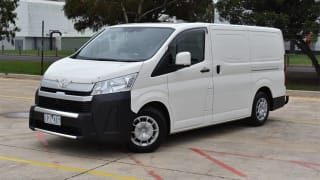Our test vehicle is the 116 LWB Crew Cab which with 2.1-litre four-cylinder turbo-diesel engine, seven-speed automatic and rear-wheel drive has a list price of $60,500.
Our example is fitted with numerous factory options including Obsidian Black metallic paint, colour-coded front and rear bumpers, cabin bulkhead with fixed window, radar adaptive cruise control, cargo bay LED light bar and comfort seats with lumbar support package.
It also has the Comfort Package which comprises ‘luxury’ interior paneling and roof lining, rear grab handles, track-style load securing system in the cargo bay and hard-wearing cabin flooring. All up these options add more than $7000 to the bill, resulting in a total as-tested price of $67,765 plus on-roads.

So, we’re talking about $70K driveaway here, which sounds Mount Everest-steep when compared to rivals like the Hyundai iLoad Crew ($44,730), Toyota HiAce LWB Crew ($48,240) and Ford Transit Custom LWB DCiV ($50,590).
However, it does offer some niceties as standard equipment, beyond its workhorse-style 16-inch steel wheels with 205/65 R16 tyres and full-size spare. There’s now AEB with pedestrian detection, blind-spot monitoring and lane-keeping assist plus a chrome grille and interior package, beautiful leather-bound steering wheel with height and reach adjustment, fold-down armrests, quick-release rear seat anchorage system if you need to remove them when using it as a van, heated door mirrors, reversing camera, daytime running lights, front and rear parking sensors and more.

The multimedia system with 7.0-inch touchscreen and steering wheel controls features voice commands, digital radio and multiple connectivity including Apple CarPlay/Android Auto.

Other options not fitted to our test vehicle include rear barn-doors with 270-degree opening, digital rear-view mirror with auto-dimming, LED intelligent light system and front passenger bench seat which creates a six-seater (3+3) cabin layout.


















